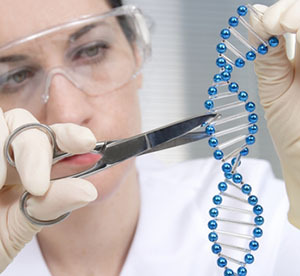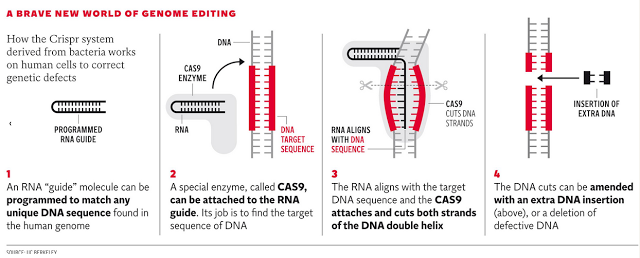CRISPR Technique with Cas9 Enzyme To Alter Hereditary Traits Easily
 Note: The original paper is found in the UK based magazine website for the Independent entitled “CRISPR gene therapy: Scientists call for more public debate around breakthrough technique”
Note: The original paper is found in the UK based magazine website for the Independent entitled “CRISPR gene therapy: Scientists call for more public debate around breakthrough technique”
The technology to alter the human race is almost here and the newest technique in genetic engineering that is making waves is something known as the CRISPR Technique. The quotes says that it can “…be used to rewrite genetic defects to effectively cure diseases in mice and human stem cells”. It is able to correct the mutations in cells which lead to diseases. The acronym stands for “Clustered Regularly Interspaced Short Palindromic Repeats“. It is a type of RNA sequence that have traditionally only been in bacteria types but the genetic researchers have been able to take that unique genetic sequence and used it in the cells of other organisms with cells which might be more complex like mice and humans.
The sequence is a type of immune function and works as a guide. The enzyme/protein it guides is something known as the Cas9 protein to a very specific, target area in the DNA. Apparently this enzyme called Cas9 has the ability to “…cut the double strand, nick it, or even knock down gene expression“. Once the target DNA area had been cut or changed in some way by Cas9, then the double strand area can either be repaired or have a DNA segment inserted into the spacing. A group of Chinese researchers at the Shanghai Institute for Biological Sciences were able to use the CRISPR method to get the Cas9 to the right mutated allele and make a cut/cleavage. New alleles that were correct were added when the repairing process began. The method was tested on mice with hereditary mutation of cataracts and a large percentage of the zygotes that had the technique employed developed into baby mice without the cataracts. Another group tried it on the mutation causing cystic fibrosis. The overall opinion at this stage is that compared to other ways to cut, edit, and paste parts of the DNA around, this method compared with other gene editing techniques, it was straightforward.
One of the chinese researchers went on to even claim the following “…I think CRISPR/Cas9 system may be the easiest strategy to cure genetic disease than any other available gene-editing techniques,” – For more information we suggest looking at least over the abstract for the article “Cas9 as a versatile tool for engineering biology”
Multiple high profile researchers have commented that it has the potential to “…revolutionise human gene therapy and genetic engineering”. The first group of people to get the process to even work was Professor George Church of Harvard. He is the director of the open access platform for people to share the data in their genomes known as the Personal Genome Project started back in 2005.
However, it was Jennifer Doudna & colleagues from Berkeley (at the Doudna Lab) in recent years were the first group of people to show that the technique can be effective in application on genetic engineering. It has worked on human cells and lab mice embryos.
It is noted that it might be maybe 1-2 decades before the technique can be implemented on IVF embryos (In Vitro Fertilization).
The following picture above was taken from the Next Big Future website.
So how would the method work?
Remember that there are three different types of RNA in the human cells. Besides the sex cells or gametes in humans, which would be the sperm and eggs, as well as the red blood cells which have no nucleus, every single cell that is in the human body has a nucleus with the necessary 23 pairs of chromosomes. The chromosomes are shaped either like an X or Y. they are actually just winded up chromatin loops which are winded up some more.
Within the chromatin are where the actual double strands of DNA wind around histones, creating something known as a nucleosome, which is further wrapped into solenoid shaped parts.
We are talking about it at the level of the actual double strands. The method guides a type of RNA sequence with the Cas9 to the exact area of the DNA with the genetic mutation. The Cas9 can come in, and cut the area of the mutation away. The double strand can then either just repair itself or an extra DNA segment is popped into the space that was created from the cleavage.
So how does this affect us, people who wish to become taller?
One of the main things I have always said is that even after all the research is done and every single possibility checked, we might reach the conclusion that there is nothing we can do for adult height increase that does not involve some type of invasive surgery. At this point, I would actually be willing to suggest that their is no alternative to the surgery method.
What I am willing to propose from the research being done is a faster, cheaper, less painful way to break the long bones (aka distraction) to height increase surgery. I am willing to make some type of compromise if the science has been completely exhausted and their is no clever way to elongate bones without using some type of chisel and hammer to at least cause the first break in bones.
If however, the readers of this website still refuse the method, then there is nothing we can do. The only option at that point is to hopefully find a way to help our children and offspring, the people who will carry out genetic lineage become taller. I will not be too selfish and hope that I would become taller as a adult. It if doesn’t work, that is okay as long as the research continues and I find a way to serve humanity. It would make more evolutionary sense to do everything in my power to help my future offspring to have the genetic advantage of extra height.
The most obvious area of our current modern lives where adult human height still means a lot is in the dating world. It might not mean a lot to women, but for men it means a lot. When young women in their 20s are asked directly at face value why they seems to always gravitate towards taller men no matter what the situation, the answer after some serious probing into their psyche and deep motives reveal that they just wish to produce offspring that are taller than they were. Maybe due to some warped low sense of self for being short themselves, they felt a need to overcompensate for their genetic “hindrances” by looking for a “genetically healthy” male. Obviously height is the easiest indicator of genetic fitness in human males and that is the measuring stick females of almost all human cultures have used to judge the worthiness of men at some level or another.
If we remember basic gene therapy information, there is two different ways that gene therapy can work. You have the 1) somatic gene therapy, and 2) the germ line gene therapy.
Whereas the somatic gene therapy would only have some type of medical benefit for the person, germ line gene therapy, which the CRISPR technique does, will mean the entire rest of the generations to come will have their hereditary trait.
If this new genetic technique is proven to work, that argument that females have been making since the beginning of human history over their biological/reptilian brain egocentric validation for their choice in taller men about worrying over having smaller offspring will no longer be valid. If we as genetic engineers can go into the human IVF embryo, using the CRISPR method, and alter the 5-6 most influential genes that affect human height, then our offspring will be able to grow upwards of maybe 4-5 inches taller than without the gene alternation. Obviously it has been shown in multiple genome-wide association studies (GWASs) meta-studies of the SNPs/genes that have some effect on human height that there is supposed to be around 200-500 or so genes that have some effect. We just need to target the top 5-6. Remember pareto’s principle and how uneven distributions work in nature.
In previous articles that I (and Tyler) have written about the exact genes in the genome which have a higher than average effect on the overall adult human height, we found elements like HMGA2 (source) (source 2), FGFR3, and GDF5 have a huge effect on human height from the way they regulate the rate of endochondral ossification and how fast the epiphyseal plates mature. Take a look at the study “A common variant of HMGA2 is associated with adult and childhood height in the general population”
Of course in recently years at least 2 dozen new genes also seem to have some effect, but at a smaller degree. (source) Take a look at the study “Genome-wide association analysis identifies 20 loci that influence adult height”
The other approach is to actually induce a type of slight matution into an average embryo with normal traits to give their abnormal body abilities. We learned from studying the genetics of families who have had the pituitary gigantism causing condition that the AIP gene (Aryl hydrocarbon receptor-interacting protein) has a slight mutation. (source) That is just one gene that has been mutated, and the result is familial genetic change where multiple members of the family become tall individuals. Why not use the CRISPR method to change the AIP gene? – For more information we suggest reading the article “AIP-Related Familial Isolated Pituitary Adenomas”

